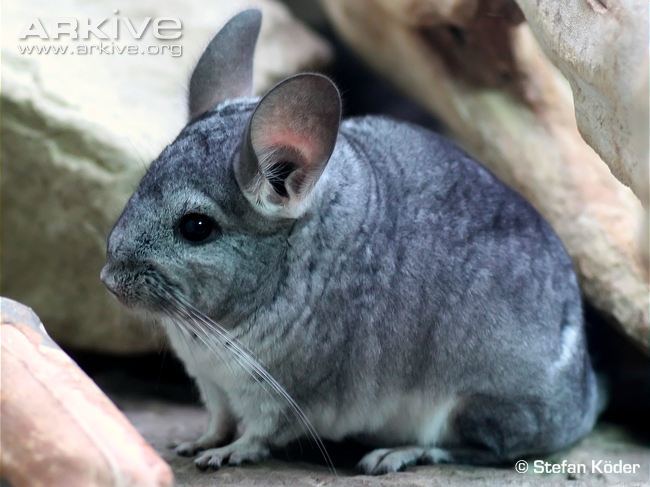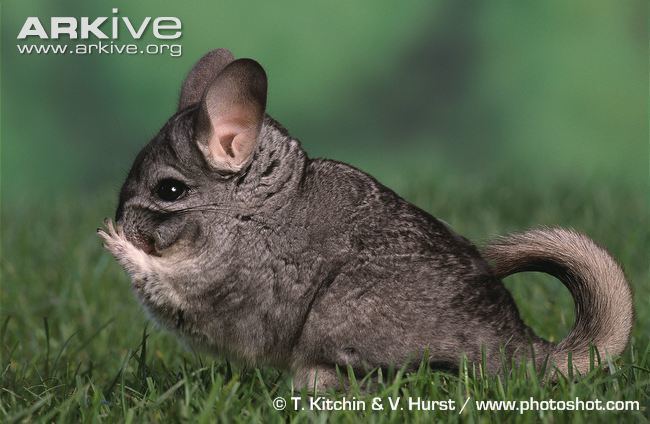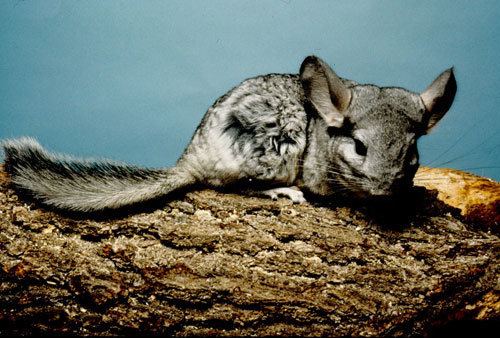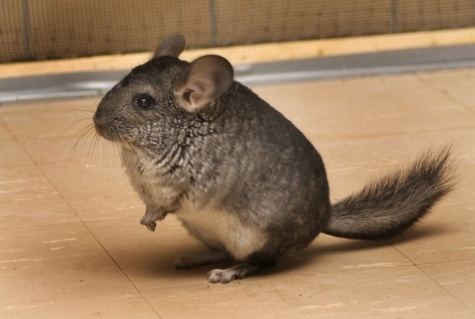Length 30 cm (Adult) | Phylum Chordata Lifespan 10 years (In the wild) Trophic level Herbivorous | |
 | ||
Conservation status Critically Endangered (Population decreasing) Mass Male: 370 – 490 g (Adult, In the wild), Female: 380 – 450 g (Adult, In the wild) Similar Chinchilla, Octodon, Rodent, Degu, Short‑tailed chinchilla | ||
The long-tailed chinchilla (Chinchilla lanigera), also called the Chilean, coastal, common chinchilla, or lesser chinchilla, is one of two species of rodents from the genus Chinchilla, the other species being Chinchilla chinchilla. Wild populations of C. lanigera occur in Aucó, near Illapel, IV Región, Chile (31°38’S, 71°06’W), in Reserva Nacional Las Chinchillas and in La Higuera, about 100 km (62 mi) north of Coquimbo (29°33’S, 71°04’W) Chilean chinchillas were reported from Talca (35°30’S), Chile, reaching north to Peru and eastward from Chilean coastal hills throughout low mountains. By the mid-19th century, Chilean chinchillas were not found south of the Choapa River.
Contents
- Adorable long tailed chinchillas eat carrots at the san diego zoo safari park
- Characteristics
- Varieties
- Ecology
- Pelt industry
- Conservation status
- References
No fossils are known.
Adorable long tailed chinchillas eat carrots at the san diego zoo safari park
Characteristics

Chinchilla lanigera is smaller (wild animals have body lengths up to 260 mm (10 in)), has more rounded ears, (45 mm (1.8 in) in length), and longer tails than C. chinchilla; its tail is usually about a third the size of its body (up to 130 mm (5.1 in) compared to 100 mm (3.9 in) in C. chinchilla). The number of caudal vertebrae is 23 in C. lanigera, and 20 in C. chinchilla). Males typically weigh 369–493 g (13.0–17.4 oz) (mean: 412 g (14.5 oz)) and females weigh 379–450 g (13.4–15.9 oz) (mean: 422 g (14.9 oz)). Domesticated animals are larger than wild ones and more sexually dimorphic, with the female weighing up to 800 g (28 oz) and males up to 600 g (21 oz).

The word lanigera translates into "bearing a woolen coat", yet chinchillas do not have a woolen coat, but instead one consisting of hair. Their hair is 2–4 cm (0.79–1.57 in) long, with gray, white, and black bands; it is silky, extremely soft, and firmly adhered to the skin. Up to 75 hairs, 5–11 mm (0.20–0.43 in) in diameter, emerge together from a single hair follicle. Vibrissae (whiskers) are abundant, strong, long (100–130 mm (3.9–5.1 in)), and emerge from single follicles. The general color of their upper parts is bluish or silvery gray; the underparts are yellowish-white. The tail has long, coarse, gray and black hairs on its dorsal surface, 30–40 mm (1.2–1.6 in) long near the body, 50–60 mm (2.0–2.4 in) long near the tip, and form a bristly tuft that exceeds vertebrae by 50 mm (2.0 in)
In the wild, they breed between October and December, which are the spring months in the Southern Hemisphere.
Its karyotype has 2n = 64 and FN = 126.
Varieties
Three different types of C. lanigera are commonly recognized: la plata, costina, and raton.

The la plata type has better-developed musculature and heavier bone structure than the other two types. The typical la plata looks more roundish or compact, with a short, wide head, a large distance from one ear to another, and a relatively straight dorsal line. The shoulders are often as wide as the chest and rump. The ears are short and nearly round.

The costina type is weaker in musculature and bone structure, with the most distinctive feature being the longer hind legs. The fore legs are shorter and placed closer together, and the shoulders are narrower. The vertebral column is more arched; the neck line is sometimes very deep, forming a slight hump on the back of the animal. When viewed directly from the front, the head is V-shaped, the nose is pointed, and the distance between the ears is rather wide. The ears are long and positioned at an angle around 45°.
The raton type is reminiscent of the la plata type in its body structure. The nose is pointed as in the costina, and the ears are positioned very close together and rather horizontal; it is distinctively smaller, on average.
Ecology
Climate in the chinchillas' habitat is rather harsh, with summer temperatures climbing during the day to up to 30 °C in the shade and dropping to 7 °C at night (or below the freezing point in winter).
Pelt industry
See Fur industry
Conservation status
The Chilean chinchilla is endangered, with the second-highest conservation priority among Chilean mammals. It was previously listed as Critically Endangered.
